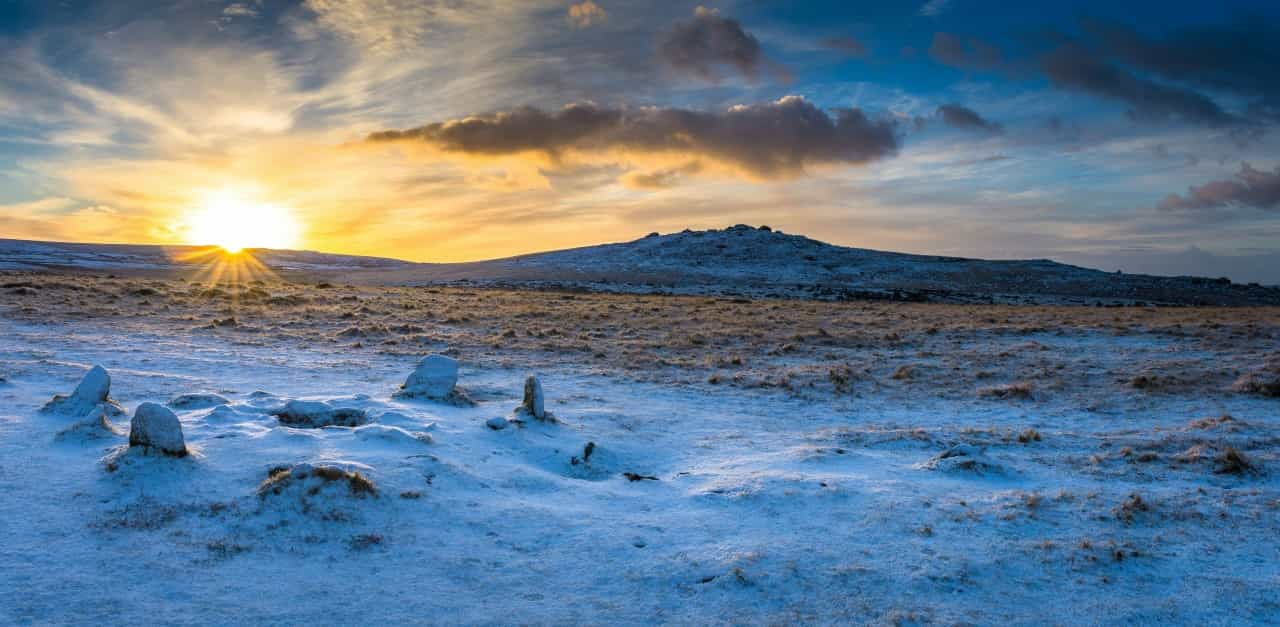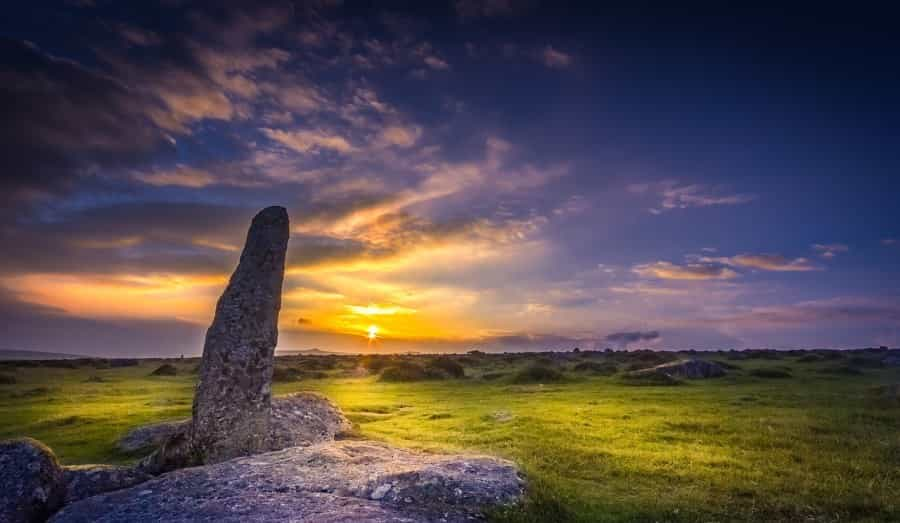Dartmoor Cultural Highlights

Human occupation on Dartmoor dates back thousands of years, and life on the moor is deeply entwined with its rugged landscape and fascinating history. It’s a wild and beautiful place that has captivated artists and writers from J.M.W. Turner to Sir Arthur Conan Doyle, and the sites that inspired them remain largely unchanged today. Experience them for yourself with our guide to Dartmoor culture, which takes in prehistoric settlements and medieval ruins to explore, local legends, traditional celebrations and some fabulous places to go for a walk.
Dartmoor's historic sites
Prehistoric sites
Dartmoor is dotted with prehistoric remains, most notably the two former settlements at Grimspound and Merrivale.
Grimspound
A former Bronze Age settlement that's home to a stone enclosure, the remnants of more than 20 stone roundhouses and a boundary wall, Grimspound dates back to around 1500 BC. For a great overview, park at Bennett’s Cross and walk in on the waymarked Two Moors Way. This route takes you past Hookney Tor, which has an elevated view of the site, and from there you can descend to explore (a 3-mile round trip). If you’d like to learn more about Grimspound and its original purpose, Legendary Dartmoor’s guide is a good place to start.
Merrivale
Merrivale is a former settlement and ritual site with megalithic monuments including a double stone row with around 150 standing stones, a stone circle, a kistvaen (burial chamber) and an impressive four-metre standing stone. Thought to date from the early Bronze Age, this extensive complex also has the remains of 50 former roundhouses near the road. In a small valley just off the B3357 between Tavistock and Princetown, it’s easy to reach as it's just a short walk from the Four Winds car park. English Heritage and Visit Dartmoor both have interesting features on the site.

Medieval and later historical sites
Buckfast Abbey
In a valley beside the River Dart on the southeast edge of the moor, the restored Buckfast Abbey sits on the site of a former Saxon monastery dating to 1018. Dissolved in the 16th century during the reign of Henry VIII, it was rebuilt from 1882 and is still home to a working community of Benedictine monks.
If you’re planning to visit, look out for the church’s religious treasures, a vaulted lantern ceiling, and striking modern stained glass in the Blessed Sacrament Chapel, Outside, the tranquil gardens overflow with lavender and roses in season, The church (closed during daily religious services) and gardens are free to visit, while the Monastic Way Exhibition (small fee) has interactive screens exploring the Abbey’s history. For more information on what you can see and do here, visit the Abbey’s website.
Okehampton Castle
Dating back to the 11th century, Okhampton was once Devon’s largest castle. Today it’s an atmospheric ruin perched on a grassy hilltop above the River Okement, with great views over the north of the moor. Wander among the remains of the keep, great hall, chapel and gatehouse, and if you’d like to learn more about them, there’s a free audio tour. We’d also recommend a walk in the surrounding woodland (renowned for bluebells in spring) or a picnic by the river. The English Heritage website has full details of opening times and prices.
More Dartmoor historic visits
If you'd like to explore more of the area's history, head to Castle Drogo, an impressive 20th-century country house in a commanding position high above the beautiful Teign Gorge. Lydford Gorge is another lovely site, with connections to the Anglo Saxons, Vikings and Normans; it inspired several Victorian artists in search of the Picturesque. A walk through the woods here will show you why, and takes in the 30-metre Whitelady Waterfall.

Cultural traditions
Dartmoor Folklore
At night the moor can be a spooky place, and it has its fair share share of legends associated with sites that you can still visit today. Visit Dartmoor’s Myths and Legends Trail outlines some of the most well known.
The most famous of these is the tale of Kitty Jay, an 18th-century milkmaid from the village of Manaton who took her own life after being betrayed by her lover. As was the custom, she was buried at a crossroads outside the village in order to confuse her restless spirit. Jay's Grave marks the site where she was buried, and fresh flowers are said to appear here every day, although no-one admits to placing them there.
There are many tales of the Wisht Hounds, a pack of ghostly dogs said to prey on lone travellers, most closely associated with Wistman’s Wood and nearby Hound Tor. Sir Arthur Conan Doyle visited the tor in 1901 and subsequently wrote his most famous Sherlock Holmes story, The Hound of the Baskervilles. Surely no coincidence?
We’re a little more sceptical about the tale of the Hairy Hands, ghostly appendages said to appear from nowhere and steer unsuspecting drivers from the B3212 road between Postbridge and Two Bridges. But just in case you’re going that way…
If you love a good ghost story, Legendary Dartmoor has an impressive list of these and other local folk tales that will send a shiver down your spine.
Annual events in Dartmoor
- Dartmoor Folk Festival: Held in August every year, this festival in South Zeal sets out to preserve and celebrate the musical traditions of the moor. Alongside an impressive line-up of local and national folk musicians, it also features traditional Step Dance and Broom Dance competitions and Morris dancers. With workshops, craft stalls, ceilidhs and games, it’s a lively and colourful event that’s well worth a look.
- Lustleigh May Day: Held on the first Saturday in May, Lustleigh’s annual celebration preserves traditions dating back centuries. Featuring Maypole dancing, the crowning of a May Queen, a parade, traditional fairground games and Morris dancers, it’s a good bet for a family day out.
Local arts and crafts
Dartmoor’s dramatic landscapes, folklore and natural beauty inspire a flourishing community of local artists and artisans, from sculptors to painters and glass blowers. If you’d like to see some of their work, here are some places to visit.
Dartmoor artisans and galleries
-
The self-guided Dartmoor Artisan Trail, devised by photographer Suzy Bennett, focuses on traditional skills, with details of blacksmiths, furniture makers, woodturners and potters who live and work on the moor. Many of them also offer the chance to try your hand at making something, and the trail’s website also has some great pictures of them at work.
-
Visit Dartmoor’s Creative Dartmoor Trail lists galleries, studios and craft centres all over the moor, including some that run creative workshops.
-
Chagford’s sculptors, ceramicists and painters have their own page on the village website.
Craft markets
-
Widecombe-in-the Moor (Thursdays, April to October) – weekly craft market in a National Trust property.
-
Tavistock Arts Market – first Saturday of the month in Butcher’s Hall.
-
Ivybridge Artisan Market – first Saturday of the month at The Watermark.
-
Bovey Tracey – annual summer craft festival featuring over 200 makers, plus workshops, demonstrations, talks and films.
-
Princetown Arts Festival – annual festival held in July or August every year.
Museums
The Museum of Dartmoor Life
Housed in a former 19th-century mill on the northern edge of the moor, The Museum of Dartmoor Life explores Dartmoor’s heritage, including its prehistoric history, nature, local legends and traditional working practices. Historic artefacts and photographs sit alongside reconstructions of a Bronze Age hut, a Victorian kitchen, a blacksmith’s forge and a wheelwright’s workshop. There are activities for children, and it’s also a handy source of local information. It's open Monday to Saturday from March to October.
Moretonhampstead Motor Museum
This museum in Moretonhampstead’s former bus depot displays more than 150 classic cars and motorcycles dating back to the 1900s, as well as motoring memorabilia and children’s toys. Moretonhampstead Motor Museum is a real labour of love, and owner Frank Loft is often on hand to introduce visitors to the collection and pass on stories about the exhibits. Open Tuesday, Wednesday, Thursday, Saturday and Sunday.
There’s so much to discover when you visit Dartmoor, from the artisans who preserve the park’s unique cultural heritage to evocative natural and historic sites where you can experience the magnificent landscape that inspires them at first hand. It’s time to start exploring.
Do you need somewhere to stay? Check out Pitchup’s collection of Dartmoor campsites